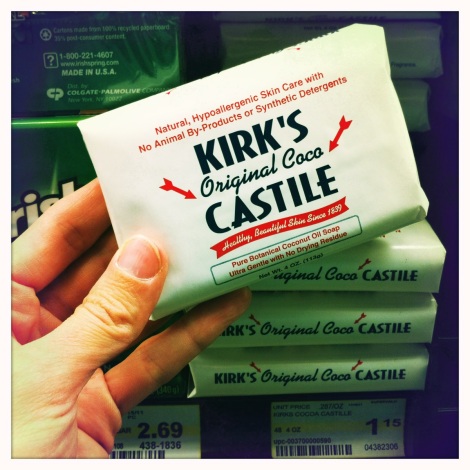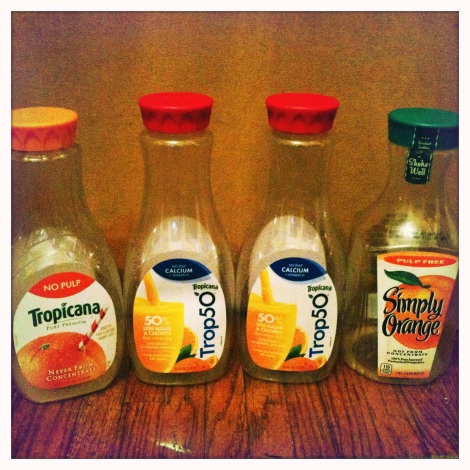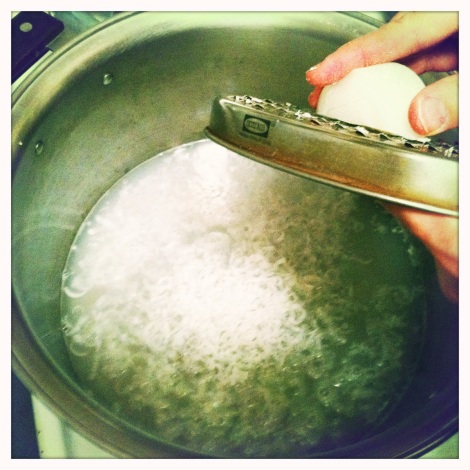
A sampling of detergents found in the laundry room of my apartment building
I learned a few things at the mall.
It was over 15 years ago that my friend Laura Gillen made me aware of laundry as a form of pollution. I was working at a luggage store in Gaviidae shopping mall, and she worked at the toy store next door. When she mentioned earth friendly detergent, I remember my own blissful ignorance. “Wait, what’s wrong with regular detergent?” I inquired. But Laura had worked in a vegetarian restaurant in Chicago where people discussed such things.
She revealed that washing clothes is a major source of water pollution in the United States. When I stopped to think about it, it made perfect sense. Just about any agent used in massive volume is going to be a major pollutant. The irony wasn’t lost on me–we dirty the environment to clean our clothes. Some soaps, however, are dirtier than others.
What is “Clean?”
Cleaning agents take something away: grease, grime, germs, stains, scum–but also leave something behind. We breathe their fumes and absorb their residues through our skin. We send them down the drain and into the world where they affect the delicate chemistry of ecosystems. So what is the right balance? When do cleaning agents become a greater contaminant than the dirt they are designed to clean? And what about all those plastic bottles?!

This aisle makes me panicky. The plastic! The pollution! I’m hyperventilating.
The chief pollutants in your average jug of laundry soap are surfactants and optical brighteners.
Surfactants do the main work of cleaning. Surfactant molecules have a water loving head and an oil seeking tail. When you mix them around in a washing machine they clean by emulsifying. The tails bind to oil which is pulled into the water through agitation and eventually suspended inside a wall of water-loving surfactant molecule heads. Learn more about the chemistry involved.
Optical Brighteners, on the other hand, do not clean your clothes. They add a residue of chemicals that absorbs ultraviolet light and emits it back as visible blue light. This mask makes your clothes appear brighter.

How they affect you
Popular laundry surfactants like nonylphenol ethoxylate (NPE) and and linear alkylbenzene sulphonate (LAS) have been linked to disruptions in the endocrine system. Such disruptions can cause cancerous tumors, birth defects, and developmental disorders like ADD, sexual development problems; they can affect potentially anything hormone-related. Optical brighteners bind to and irritate the skin, which is why they are omitted from detergent for baby clothes. Because they are designed to not rinse away, they cling to everything; enveloping your sheets, towels and every bit of material that touches your body. They make clothing stiffer, so additional chemicals are added to detergent to counteract this effect.
How they affect the environment
The manufacturing of these cleaners and optical brighteners releases carcinogens and reproductive toxins into the environment. They are slow to biodegrade and toxic to aquatic life, damaging the gills of fish and killing their eggs. They change the surface tension of water, causing fish to absorb more pollutants like pesticides. They cause algae bloom which chokes waterways, depletes water of oxygen, and destroys aquatic habitats.
So what are you supposed to do with those mounds of dirty laundry?
Use less soap
Any detergent is a potential toxin–even the eco-friendly ones– so always use the minimum necessary to get the job done. Oftentimes half the recommended amount of conventional soaps like Tide is sufficient to get your clothes clean. Spot treat stains, so that you can decrease the soap in the rest of the load.
Decrease your laundry overall by re-using towels several times. When possible, wear clothes twice before laundering. Consider low maintenance materials like wool, which needs to be laundered less than other materials.
Use different soap
If you see biodegradable on the label, that’s a good start. It probably means it’s free of phosphates and optical brighteners. I have tried a few kinds of eco friendly soaps. I like powdered soap in theory because it is more concentrated and minimally packaged. But I had to give up on Seventh Generation powder because of blotchy white residue it left on dark clothes. I tried dissolving it in scalding water and then straining it before adding it to the machine, but I still had trouble. I switched back to liquid Restore the Earth brand. I can re-fill my jug that I bought 10 years ago at the Wedge.

The jug is refillable at the Wedge. Restore also makes dish detergent.
Cut down on whites
The last time we had a family dinner at my mom’s, she spent a half an hour afterward trying to remove food stains from her white table cloth. What’s the point of a white table cloth, napkins, towels, or sheets for that matter? How about a nice Robin’s Egg Blue? Lilting Lavender? Misty Gray? Burnt Sienna? Or a lovely plaid of all four? Plaid covers up everything! It takes more chemicals and effort to keep whites white.
Use gentle whiteners
For the whites you have, a 1/2 cup of baking soda, vinegar, borax, or hydrogen peroxide will brighten whites without bleach or optical brighteners. Peroxide whitens best when you to let it soak for 8 hours to get the full effect. 1/2 cup vinegar plus 1/2 cup borax together is reputedly a super whitener. Vinegar also removes odors from fabrics and softens them naturally.

20 Mule Team Borax. A Natural Cleaning Classic.
Make your own laundry detergent!
Why? So many reasons. You can save big money, re-use your plastic bottles, and include just the ingredients you want to include. Also it’s easy, and fun (or at least mildly diverting). After finding a recipe online this week I set out on a mission. See the
recipe.
Ingredients to gather:
1 bar of soap (this is your surfactant)
I cup washing soda (water hardness sequesterant)
1 cup borax (cleaning booster and natural brightener)
About 3 Gallons Water
Grater
Medium sized pot
Container and spoon large enough to stir it all up
I’m told I can use any bar of soap I like, so I do a little googling. Fels Naptha and Zote are popular choices for homemade laundry soap, but I’m not satisfied that they are the most eco-friendly. I decide to try a simple vegetable based soap for my first batch of homemade liquid laundry detergent. Most soaps like Ivory and Irish Spring are made with animal fat.

Kirk’s Castile. A simple, inexpensive bar of soap from Kowalski’s
Next I need washing soda. Most people nowadays don’t know this product exists, so when I call ahead at Kowalski’s they claim not to have it. But I find it there right next to the Borax. Lund’s also carries washing soda. Target downtown Minneapolis does not. Grocery stores seem to be a good place to check.

Super Washing Soda: the laundry aisle’s best kept secret!
At Kowalski’s I am distracted by a new discovery. Pure powdered soap –48 loads worth in a minimal package. Made in Minnesota! I am intrigued. I am tempted. But I am determined to stick to my original mission. Do let me know if you try this captivating product!

Pure Laundry Powder: 48 Loads for $10.99

Pure Laundry Powder Ingredients–these look familiar.

Did I bring my own bag to Kowalski’s? But of course!
The recipe calls for a 5 gallon bucket with a lid. I assume this gentleman stirs the detergent up and stores it in the same bucket. Great if you already have one–but would I buy a big plastic bucket just to make laundry detergent? As if! I can stir it up in a wastebasket I already have. As for storing the detergent, I arrive at a simple solution. On my way home from Kowalski’s I walk down the alley behind my apartment to raid recycling bins. Soon enough I am the proud owner of a fine set of laundry detergent vessels. And I learn that people on my block drink a lot of orange juice.

Reclaimed Plastic: These discarded bottles have a new job to do.
I heat 4 cups of water on the stove top and start grating soap in. The water should be kept just under boiling.
After grating, I stir the soap until it is fully dissolved. I place a clean wastebasket in the bathtub and fill it with almost 3 gallons of hot water. I am careful not to use more liquid than I have the capacity to store in my plastic bottles. I dump in the soapy water from the stove top and stir well.

Stir it up
Next I add the washing soda and stir for 2 minutes. Then borax and stir for another 2 minutes. Now the concoction is ready to congeal overnight. Brian and I saunter off to Chiang Mai Thai for dinner to blow the great saving$ we anticipate from the treasure trove of laundry detergent in the bathtub.

The next morning
First thing in the morning I leap out of bed to see the results. My detergent has congealed, but isn’t as thick as some of the comments on The Simple Dollar suggest. This may be because his bar of Lever 2000 soap was 4.5 oz as opposed to my 4 oz bar of Kirk’s. Or it could be because mine was a vegetable based soap. Either way I am glad because I don’t need to thin it with water in order to pour it through a funnel and into my orange juice bottles.

I think someone put a little too much calcium in the orange juice
Does it work?
I ran a load of whites with 1 cup of homemade laundry soap and got good results. I noticed in comments on The Simple Dollar blog that Boberta tested it in a science fair, and found the home recipe was more effective than Tide at removing beet juice from a t-shirt. The clothes smell mostly neutral, with a subtle clean scent of Kirk’s soap.
On the topic of laundry scents–there is new a product on the market that horrifies me.
Making Scents
Put essential oils on your skin instead of in your clothes when you want to smell pretty. Consider
making your own a drawer sachets to scent your clothes, rather than washing lots of perfumes down the drain in your laundry load.

Essential Oils: shove this rainbow up your nose, Amy!
Is that classic fresh-from-the-dryer scent what you crave? Check this.
Fresh Laundry Perfume!
Thanks for accompanying me on this laundry adventure. And thanks for reading the Wednesday Post.

Now orange you glad your laundry detergent is easy on the earth?
Links:




















How about that stuff they call “bluing” that has a picture of a grandma on it? http://en.wikipedia.org/wiki/Mrs._Stewart%27s_Bluing
Jim, bluing does not clean clothes, it dyes your clothes ever so slightly blue to cover up yellowing on whites. Mrs. Stewart’s is made with a synthetic dye called “Prussian Blue” and it only takes a few drops per load so I would guess it’s gentler on the environment than bleach. Many whites you buy are pre-dyed with blue to prevent yellowing, but the effect wears off after repeated washings. Apparently this laundry strategy was discovered long before synthetic dyes were invented:
“Blue colorings have been added to rinse water for centuries, first in the form of powder blue or smalt, or using small lumps of indigo and starch, called stone blue. After the invention of synthetic ultramarine and Prussian blue it was manufactured by many companies, including “Mrs. Stewart’s Bluing” [1] in the USA, Reckitt’s Crown Blue [2] in Hull and Dolly Blue in Cumbria.[3] It was popular until the mid-20th century in the UK and USA, and is still widely used in the USA, India and Pakistan. In many places, it has been replaced by bleach for its primary purpose.” (Wikipedia)
Greetings Allison: Did you ever try the Pure Laundry Powder? I was recently introduced Pure Soap Flake Company, MN manufacturers of Pure Soap Flakes, Pure Laundry Powder and Pure Soap Bars, at my local co-op. They are one of a handful of US companies making pure laundry / bathing / cleaning products that are vegetable-based and totally free of unhealthy bleaches, dyes, chemicals, perfumes, GMOs, phosphates and sulfates. Discover more at http://www.puresoapflakes.com. I am collaborating with Christine Jones, Head Flake of PSFC, and we would love to hear your experiences and comments. Loris Sofia Gregory, Healthy Home Coach, Beautiful Necessity, Apple Valley, Minnesota
Hi Loris Sofia, I have not tried it yet. Have you considered making it available for purchase in bulk at co-ops? I typically bring my own container to buy Restore the Earth brand liquid detergent.
Hi Allison: Good to hear from you! PSF products are available at most TC co-ops, including the laundry powder in bulk. What is your nearest co-op? I can ask owner Christine Jones about sending you some complimentary samples if you are interested and making sure her great products are available at your co-op. Thanks for your interest in Pure Soap Flake Company!
Loris Sofia Gregory Beautiful Necessity: Health Coaching for You, Your Home and the Earth Research & Writing for Healthy Sustainable Life “Good News for Health Coaches” Editor, Health Coach Training, FL Apple Valley, Minnesota 952.431.5586 lorissofia@frontiernet.net http://www.lorissofiagregory.com
I use a very similar recipe, but also add about 3/4 of a large bottle of lemon juice (for scent) and half an ounce of tea tree oil (for disinfecting) for a four gallon batch. Voila! you now have dish soap too. Clothes smell like they have been line dried in the sunshine and grease on dishes comes off easier than it does with commercial soap. I make sure glasses are well rinsed because of the tea tree oil but, my dishes actually squeak when I am done. Dingy clothes are an issue, but I am working on that as well. Instead of fabric softeners or dryer sheet, I am going to use Stoney Mountain Farm Earth Friendly Wool Dryer Balls USA farm raised, farm made!Our 100% all natural no dyes, no chemical wool dryer balls.Help save the enviornment and reduce household expenses!www.stoneymountainfarm.com
I just got them in the mail yesterday and haven’t tried them yet, but I am excited and will post the results in a day or so.
Hi!
My mother in law spot treated my favorite sweater (natural cotton) and now it has a light spot on it that is especially noticeable in direct sunlight. I assume this is from the optical brighteners 😦
Is there anything I can do, or am I out of luck here?
Hi Amy, just saw this comment, sorry! I would try washing it a few more times, maybe the brightener will rinse out or distribute more evenly?